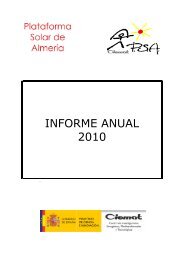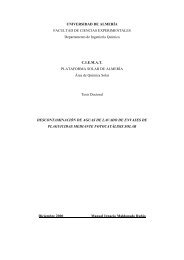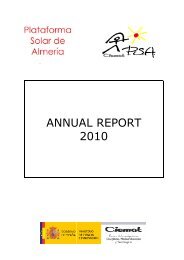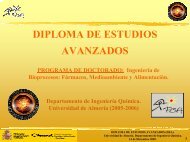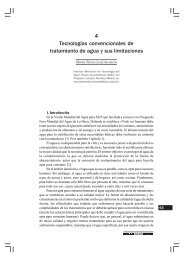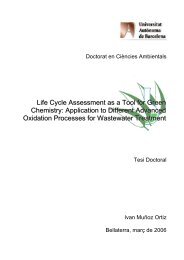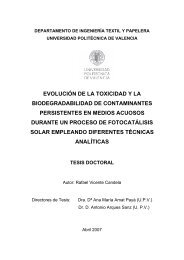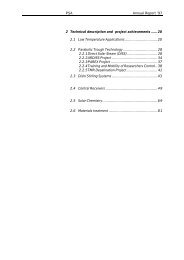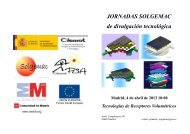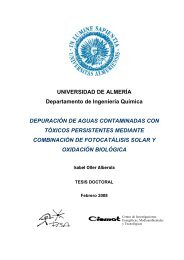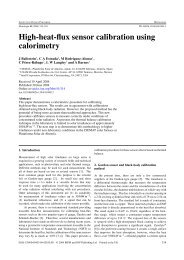Annual Report 2006 - Plataforma Solar de AlmerÃa
Annual Report 2006 - Plataforma Solar de AlmerÃa
Annual Report 2006 - Plataforma Solar de AlmerÃa
Create successful ePaper yourself
Turn your PDF publications into a flip-book with our unique Google optimized e-Paper software.
PLATAFORMA SOLAR DE ALMERÍA<br />
Purpose: The main purpose of the SolterH project is to <strong>de</strong>monstrate the usefulness<br />
of binomial renewable energies – the hydrogen vector, specifically of<br />
solar thermal energy, and its use in clean renewable hydrogen production by<br />
appropriate use of an unlimited, abundant resource such as the sun. The final<br />
purpose of this project is the <strong>de</strong>sign, <strong>de</strong>velopment and evaluation of a hightemperature<br />
solar thermal hydrogen generation system, with an important<br />
milestone at the end of the project in the testing of a 5 kW reactor in the PSA<br />
solar furnace. During the first stage of the project in 2004-2005, different<br />
possibilities of meeting technical and economic criteria were studied, evaluating<br />
the advantages and disadvangates of each. We could summarize by saying<br />
that the SOLTER-H Stage I clearly <strong>de</strong>monstrated the use of simple cycles<br />
at high operating temperatures that allow variations in the energy supply<br />
without un<strong>de</strong>rgoing any significant <strong>de</strong>crease in efficiency as good candidates<br />
for our needs. The mixed oxi<strong>de</strong>s (ferrite) cycle has all of the qualities for being<br />
an i<strong>de</strong>al cycle, that is, simplicity and relatively high temperatures, although<br />
it had the disadvantage of a lack of reliable operating data.<br />
Results achieved in <strong>2006</strong>: In the second stage of the project, commissioning<br />
of the experimental <strong>de</strong>vice was begun and the first tests with synthesized<br />
materials were done by the CSIC Instituto <strong>de</strong> Catálisis y Petroleoquímica<br />
through a supply contract. These activities consisted of preparing and synthesizing<br />
ferrites, the <strong>de</strong>sign of a particle injection system and reactor characterization.<br />
Batch mo<strong>de</strong> testing has <strong>de</strong>monstrated H 2 production using these materials<br />
for the first time in our laboratories. The batch tests did not allow us to<br />
come to a clear conclusion concerning the technical feasibility of this process,<br />
since tests could not be performed un<strong>de</strong>r the best conditions. At the present<br />
time, work is un<strong>de</strong>rway to incorporate a particle reactor for the next tests that<br />
will calibrate process feasibility better.<br />
Clean Hydrogen Production: CO 2 -free Alternatives<br />
(PHISICO2 Project)<br />
Participants: Universidad Rey Juan Carlos, CSIC, INTA, REPSOL, HYNER-<br />
GREEN y CIEMAT.<br />
Contact:<br />
David Serrano; david.serrano@urjc.es<br />
PSA Contact: Manuel Romero, manuel.romero@ciemat.es<br />
Funding:<br />
Cooperative Project fianced by the 4th PRICIT-Regional Science<br />
and Technology Plan of the Community of Madrid. Total budget:<br />
1,000k€. CIEMAT budget not including personnel: 240k€<br />
Duration: January 1, <strong>2006</strong> – December 31, 2009<br />
Motivación: Coordinate and make available to all involved, the research efforts<br />
and capabilities of groups from different institutions (URJC, CSIC, CIE-<br />
MAT, and INTA) in the study and <strong>de</strong>velopment of different clean hydrogen<br />
production processes, that is, CO 2 -emission-free, using renewable energies as<br />
the primary energy source for its generation. Two companies in the energy<br />
sector (REPSOL YPF and HYNERGREEN) have shown their intereste in monitoring<br />
the results and participate actively in the project. It is worth mentioning<br />
that CIEMAT participation in this project is not only through the group at<br />
the PSA, but also by the Chemistry Division and the Fusion Materials Laboratory<br />
Unit. Hydrogen production processes inclu<strong>de</strong>d in this project are photoelectrolysis<br />
of water, thermochemical cycles and <strong>de</strong>carbonization of natural<br />
gas. In addition to contributing to the scientific-technical <strong>de</strong>velopment of<br />
these alternatives, this project is inten<strong>de</strong>d to evaluate their mid-to-long-term<br />
60



